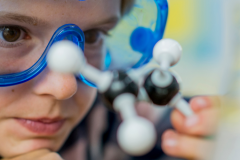Dr. Megan Levings and her team have recently published two papers on the very different functions and uses of regulatory T cells (Tregs). Tregs are immune cells that help to rein in immune responses to ensure that they don’t go too far and begin harming healthy tissues in their pursuit of foreign invaders.
- Overview
-
Red blood cell (RBC) transfusion is a mainstay of treatment for individuals requiring surgery, with traumatic injury, undergoing chemotherapy and with anemia due to bone marrow failure or other medical conditions. Despite this, red cell transfusion has been associated with poorer outcome in many of these patient populations [Hebert, 1999, Villaneuva 2013]. As well, it is a costly treatment and the product is often in short supply due to demands in excess of donor availability. Utilization trends increase year over year on a provincial and national basis, and this is unlikely to change in light of our aging population.
For these reasons, there is interest at all levels of care to ensure that RBC transfusion is undertaken only when necessary; when no other reasonable treatment option is available. My current research focuses on assessing blood transfusion practices and adherence to current recommendations.
- Publications
-
Striking emperipolesis in megakaryocytes of gray platelet syndrome
Blood
Eric McGinnis and Kate M. Chipperfield
DOI: 10.1182/blood.2019000494
06/2019Microparticle content of platelet concentrates is predicted by donor microparticles and is altered by production methods and stress.
Maurer-Spurej E and Larsen R and Labrie A and Heaton A and Chipperfield K
DOI: 10.1016/j.transci.2016.07.010
PubMed: 27470708
08/2016Acquired peanut hypersensitivity following platelet transfusion.
Ponnampalam A and Growe G and Loftus P and Chipperfield K and Bigham M
DOI: 10.1111/tme.12148
PubMed: 25180861
12/2014Should intraoperative cell-salvaged blood be used in patients with suspected or known malignancy?
Trudeau JD and Waters T and Chipperfield K
DOI: 10.1007/s12630-012-9781-x
PubMed: 22996966
11/2012Temporal trends in the treatment of severe traumatic hemorrhage.
Heidary B and Bell N and Ngai JT and Simons RK and Chipperfield K and Hameed SM
DOI: 10.1016/j.amjsurg.2011.12.012
PubMed: 22417848
05/2012Erroneous automated optical platelet counts in 1-hour post-transfusion blood samples.
Maurer-Spurej E and Pittendreigh C and Yakimec J and De Badyn MH and Chipperfield K
DOI: 10.1111/j.1751-553x.2008.01097.x
PubMed: 18752538
02/2010Concomitant and successive amplifications of MYC in APL-like leukemia.
Bruyère H and Sutherland H and Chipperfield K and Hudoba M
DOI: 10.1016/j.cancergencyto.2009.11.001
PubMed: 20113841
02/2010Platelet quality measured with dynamic light scattering correlates with transfusion outcome in hematologic malignancies.
Maurer-Spurej E and Labrie A and Pittendreigh C and Chipperfield K and Smith C and Heddle N and Liu Y and Yi QL and Barnett M
DOI: 10.1111/j.1537-2995.2009.02302.x
PubMed: 19903289
11/2009Past and future approaches to assess the quality of platelets for transfusion.
Maurer-Spurej E and Chipperfield K
DOI: 10.1016/j.tmrv.2007.05.005
PubMed: 17900491
10/2007Posttransplant diffuse large B-cell lymphoma of "lymphomatoid granulomatosis" type.
Saxena A and Dyker KM and Angel S and Moshynska O and Dharampaul S and Cockroft DW
DOI: 10.1007/s00428-002-0694-x
PubMed: 12587601
12/2002A novel immunocytochemical assay for the detection of serotonin in platelets.
Maurer-Spurej E and Dyker K and Gahl WA and Devine DV
DOI: 10.1046/j.0007-1048.2001.03302.x
PubMed: 11849219
03/2002 - Research
-
Current Project
I am currently supervising a project to audit RBC transfusions administered across various hospitals in Greater Vancouver. We will gauge whether the transfusion was appropriate or inappropriate based on most current guidelines. The cumulative results of the audit will provide information to hospital Transfusion Medicine (TM) leaders, ordering clinicians, hospital executive and the Ministry of Health (MoH), and form a baseline for future RBC Utilization Management (UM) endeavors. This information will have the potential to influence quality outcomes for patients.Grants2010-2011. Canadian Blood Services Grant. (Co-PI with E. Maurer) Comparison of in vivo outcome following transfusion of dynamic light scattering screened versus unscreened platelets.
2011. VCH Quality and Patient Safety. Development of On-line tutorial - Appropriate TM Practice for MD’s.
2010-2014. Co DIVO RCT
A randomized controlled trial of high quality platelet concentrates as determined by ThromboLUX score versus standard of care platelets in patients with hematological malignancy.
Honours & AwardsAward for Excellence in Clinical Service, UBC Dept of Pathology and Laboratory Medicine, 2011.
Faculty of Medicine Clinical Excellence in Teaching Award, UBC. May 2007.





